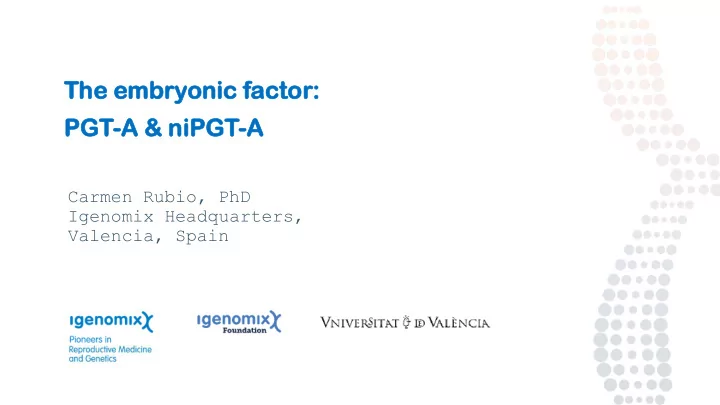

The embry bryonic onic facto ctor: PGT PGT-A A & niPGT GT-A Carmen Rubio, PhD Igenomix Headquarters, Valencia, Spain
Why y perf rform orm PGT-A? A? Objectives and Indications of PGT-A Improve pregnancy and implantation rates Objectives Decrease miscarriage rates and risk of abnormal offspring Decrease multiple pregnancies if SET if performed Decrease time to pregnancy and emotional burden Cost-efficiency Advanced maternal age (≥35 -38 years) Prior pregnancy/child with chromosomally abnormality Multiple implantation failures (≥2 failed IVF) Indications Recurrent miscarriage (≥2 miscarriages) Severe male factor infertility (low sperm count) Good prognosis patients: SET SET: single embryo transfer
How to perf rform orm PGT-A? A? Automated library preparation (Ion Chef, ThermoFisher) NGS protocol High throughout sequencing (S5, ThermoFisher) Minimize manual sample handling Short and cost – effective protocol (12-15 hrs approx.) Analysis: Ion Template prep: Sequencing: S5 Library prep Reporter software Ion Chef System system v5.4 or higher Data analysis and storage WGA and Sequence up to 96 Isothermal with Torrent Suite preimplantation fragment library amplification with Software v5.4 or higher embryos with Ion 530 construction with Ion Ion Chef System and Ion Reporter Software Chip SingleSeq Kit and server WGA: whole genome amplification
How to perf rform orm PGT-A? A? Smart PGT-A 2) Customized diagnosis algorithm NGS: millions of sequences from > 200.000 biopsies 3) Bioinfoserver Machine learning and Final results and report validated by transfer of data Mosaicism algorithm experienced scientist
How to perf rform orm PGT-A? A? MOSAICISM: Different number of abnormal cells After proper validation, four different categories were defined: Mosaicism rate was 5.8%: 3.8% low mosaic degree and 2% high mosaic degree. The incidence of mosaicism was not different for the 9 diagnostic laboratories, low and high mosaicism rates were also comparable (low mosaic: 2.4-4.4 and high mosaic: 1-2.6).
What ´ s s new? w? Conv nven ention onal Preimp eimplanta ntati tion on Gene neti tic Non-in invas asive ive meth thods ds Testi ting ng for Aneu euploi oidies es (PGT-A) A) for Aneup uploidy Testi ting (ni ni PGT-A) A) Blastocyst biopsy Embryos cultured Cell free DNA released 5-8 trophectoderm cells Day 5-day 6 from day 4 -day 6 to the media NGS NGS NGS in Spent Blastocyst Media NGS trophectoderm biopsy 45, -16, XX 45, -16, XX
Pilo lot study dy TE vs. embry bryonic onic cell-fr free DNA in SBM Embryo ryo culture re modifi difica cati tions s to decrea rease se MCC Standard Serial Transfer to 10µl Culture up to culture Washes drop on D4 D5/D6/D7 D4 embryos Washings 10µl drop D5/D6/D7 biopsy Cell free DNA Rubio et al., FS in press 2019
Pilo lot study dy TE vs. embry bryonic onic cell-fr free DNA in SBM Ion Torrent ™ Technology (S5) WGA / N NGS improvemen ements ts WGA with conventional and modified protocol After 5 minutes C C C C C C M M M M M M Time in culture: 30 30 30 48 48 72 h h h h h h Rubio et al., FS in press 2019
New NGS protocol: results pilot study vs. RESULTS DAY 6/7 RESULTS DAY 5 TE BIOPSY vs. SBM TE BIOPSY vs. SBM (N=27) (N=81) INFORMATIVITY CONCORDANCES INFORMATIVITY CONCORDANCES 81.8% 63% 100% 84% Rubio et al., FS in press 2019
New NGS protocol: results on day 6/7 vs. DAY 6 CONCORDANCE: TE BIOPSY vs. SBM FALSE NEGATIVES: FALSE POSITIVES: CONCORDANT RESULTS CONCORDANT Euploid biopsy Aneuploid biopsy With different gender RESULTS Aneuploid media Euploid media 5% 84% 8.5% 2.5% Rubio et al., FS in press 2019
NGS results TE vs. SBM ALL CHROMOSOMES CONCORDANT
NGS results TE vs. SBM FALSE NEGATIVES & FALSE POSITIVES
Pilot Study: Clinical results Prelimin iminary ary clinica ical result lts s in SET Euploid TE/ Euploid TE/ Clinical Outcome TOTAL Euploid SBM Aneuploid SBM Number of transfers 17 12 29 Mean maternal age (SD) 37.5 (2.5) 37.4 (2.3) 37.5 (2.4) Positive pregnancy test 11 (64.7) 4 (33.3) 15 (51.7) Biochemical pregnancy loss 2 (18.2) 0 2 (13.3) Clinical pregnancy rate (%) 9 (52.9) 4 (33.3) 13 (44.8) Clinical miscarriage 0 2 (50.0) 2 (15.4) Ongoing implantation rate (%) 9 (52.9) 2 (16.7) 11 (37.9) Rubio et al., FS in press 2019
Open questions? Origin of the DNA? From inner cell mass and trophectoderm cells? Mechanism? Different embryonic DNA replication? Tubulin bridges? BASIC RESEARCH (Plachta Lab) Can we improve current results by decreasing MCC? MULTICENTER CONCORDANCE STUDIES Does culture conditions or embryo quality affect the results? Could be applied with the aim of improving implantation for every IVF patient? RCT STUDY If this is the case, could transfer priorization be an acceptable alternative?
Multicenter Concordance Study (8 centres) VALI LIDATIO ATION: N: Cons nsiste stent nt conc ncor ordanc nce rates tes betwe tween en cfDNA NA and TE biopsy opsy 100 80 Concordanc 60 e 40 20 0 Center 1 Center 2 Center 3 Center 4 Center 5 Center 6 Center 7 Center 8
Transfer prioritization according to SBM results Euploid SBM 98% concordant euploid in TE Non- Informative 50% euploid in TE UNTESTED EMBRYOS Chaotic (> 6 aneuploid chr 50% euploid in TE Complex Aneuploid (3-5 chr) 75% aneuploid in TE Aneuploid (1-2 chr) 95 % aneuploid in TE
Recommend
More recommend